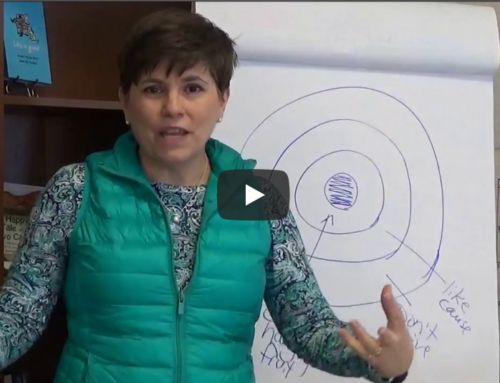 I hear this all the time: “Where do we find rich donors to give to us?”
I hear this all the time: “Where do we find rich donors to give to us?”
Ugh.
No.
No. No. No.
If you’re looking for rich donors, that tells me you care more about the money than the donor, and my friend, that is BACKWARD!
First, you’re assuming that just because someone has money, they’ll give it away.
Second, you’re assuming they’ll like your mission and give to YOU.
That’s a lot of assumptions.
If you want to raise the money you need to fully fund your budget, you need to value your donors as partners.
It’s like this: the goose is more valuable than the golden eggs she lays.
When you take care of the goose, she keeps laying the golden eggs.
Your donor is valuable for the donation they make now and all the future ones they’ll make, too.
Take care of your donor, and they’ll continue to give.
Get it?
So, instead of looking for rich donors, look for people who LOVE your organization’s mission and want to see you be successful.
Stop looking for rich donors and get strategic instead
 Being strategic about finding new donors can save you a lot of time and trouble, and bring you donors who will stick around a long time.
Being strategic about finding new donors can save you a lot of time and trouble, and bring you donors who will stick around a long time.
So why aren’t more nonprofits using this strategy to find new donors?
I believe they are stuck in status quo and continue to do what they’ve always done, even if it doesn’t really work. We’re all creatures of habit.
Here are 3 common mistakes made by nonprofits looking for new donors.
1. The Passion Myth. You may think that because you’re passionate about your cause, everyone else is, too. But the truth is, they probably aren’t. You’ll find a few people who are as passionate as you about your cause. And you’ll find more who care but don’t have the same level of deep concern. Stop expecting people to mirror your enthusiasm, and be willing to accept whatever level of concern they bring. You can fan the flames of their heart with stories and connection. Bottom line: not everyone cares about your mission as much as you do, and that’s ok. They can still give without being passionate like you. They just need to care.
2. Casting a wide net. Don’t try to appeal to your entire community. Remember, not everyone gives to charity, and of those who do, most have their favorites. Trying to get in front of your entire community is a “spray and pray” method – you’re sharing your message with everyone and hoping someone responds. It’s not usually effective. An example is getting a story in the newspaper or on TV. It’s easy to get excited about the hundreds or thousands of people who will see it, but there’s really only a small segment of the readers/viewers who will care, and of those, a smaller segment will actually take action. While getting a story in the news is a good way to raise awareness, it may not be the best way to bring in new donors.
3. Dry Pond. You’re not fishing where the fish are. You’re showing up wherever you can to speak or network and hoping that because your nonprofit does good work that people will support you. Then you’re disappointed when they don’t. This is why it’s sometimes a total waste of your time to go speak to a group or attend a networking event – they’re not the right audience for you, so they may listen politely, but at the end of the day, they’re not going to help you change more lives. Be more selective about the groups you spend your time with and you’ll see better results.
How do you avoid these mistakes and add hundreds of good, new donors to your family?
Ideal Donor Profile
 Start by creating an Ideal Donor Profile to give you an idea of exactly who you’re looking for.
Start by creating an Ideal Donor Profile to give you an idea of exactly who you’re looking for.
An Ideal Donor Profile identifies the top psychographics and demographics of your best donor, so that you can go find more people just like them.
Think about that: if you knew a few key details of your best donors, wouldn’t it make donor acquisition a lot easier?
It doesn’t have to be complicated to figure out.
Sit down with a blank piece of paper and think about your top donors. Jot down their names. What do they have in common? Think about their age, their sex, their education, and whatever else you can think of. Write each one down. If you can get at least 3-5 things, this will help.
When I worked at the food bank, I did this exercise. It was very unscientific but it worked. I simply thought about some of our best donors. Some of them were our biggest donors and some weren’t, but they were consistent and often sent words of encouragement with their check.
Here’s what I figured out about them:
- Women
- Aged 55-70
- College educated
- Attended church services regularly
- Volunteered in the community
I looked at that list and said “where can I find more people just like that?”
After thinking a bit, it occurred to me that women’s groups at churches might be a place where I could find ideal donors easily and in large numbers. I started asking around to see who belonged to a women’s group where I could go speak, and got several leads. I put together a hot presentation with a clear call to action (this is CRITICAL!), and off I went. I remember at one church, almost everyone in the room signed up to hear more about our work and how they could get involved. Several ladies handed me a check before I left, and a few days later, I got a check from the group as a whole.
The key, really, is to know who your best current donors are, then go find more people just like them.
You’ll be way more likely to get donors that will give bigger and give longer.
And you won’t have to waste any more time looking for rich people.






Can i get acopy of the guide at the library? This is gold
I did not know where to start
Which guide are you referring to?
Interesting post Sandy, capacity is just one of the many things needed for the person to be a match. Something everyone needs to be reminded of once in a while is that the amount of people capable of leaving a planned gift is huge! Someone leaving their house or other assets after death is something a lot of people have the capacity to do – based on this research too it’s important to nurture those donors – https://imarketsmart.com/does-longevity-of-giving-increase-the-likelihood-that-your-supporters-would-make-a-planned-gift/
Thanks Tim. Agreed that nonprofits need to market their planned giving opportunities. The simplest way to do that and the best way for most of our readers is to put “Remember us in your will” in newsletters and social media and other materials. All you have to do is plant the seed of the idea.